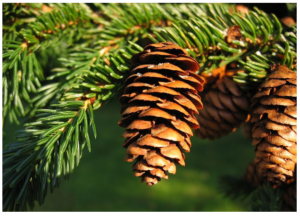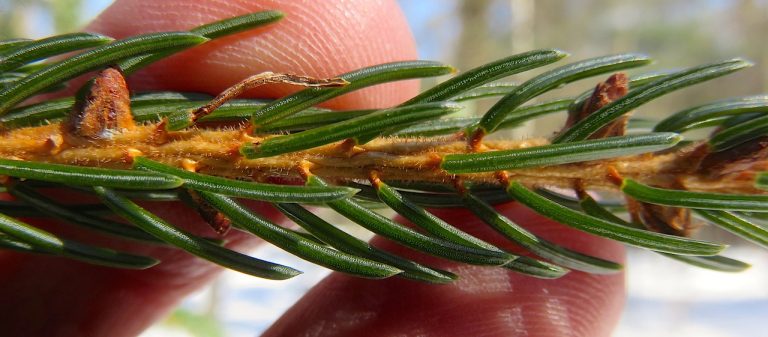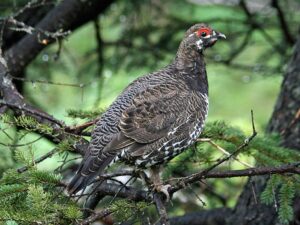
Did you know that out of around 40 spruce species worldwide, five are native to North America, and only three are indigenous to the Upper Wolastoq River Valley region? It’s true! While you are likely to stumble upon the Engelman spruce in the Rocky Mountains or find the giant Sitka spruce in a narrow region on the coast of Vancouver Island, it is unlikely that you will find them here in New Brunswick.
However, as you move through forested areas in the Maritimes, you will encounter the three native spruces of our region – red spruce, black spruce, and white spruce.
Continue reading to learn more about the most long-lived native spruce in Canada – the red spruce!
All About the Red Spruce (Picea Rubens)
The red spruce, also known as “Eastern spruce” or “yellow spruce,” is a conifer species most commonly found in the Maritimes. While it also grows in the Great Lakes and St. Lawrence regions, it is less populous there than in eastern provinces (other than Newfoundland & Labrador). Interestingly, newly exposed wood can sometimes have a dull yellow tinge – hence the name “yellow spruce”!
Red spruce trees are long-lived, medium-sized, and moderate-growth species, often living for 200 to 400 years and reaching 60 to 130 feet tall at maturity. They have dense, pyramid growth patterns, which make them attractive as Christmas trees when young. Their light and soft wood is also desirable for construction applications – particularly for lumber and musical instruments.
Most often, you will find red spruce trees thriving in high-altitude sites in eastern North America. They are shade tolerant and do better than other native spruce species in rockier sites with nutrient-poor soil.
How to Identify Red Spruce Trees?

Red spruce can be identified by their bark, twigs, needles, and cones:
Bark: Gray-brown to reddish-brown flakey bark with a red underlayer. Newly exposed wood can appear dull yellow in colour.
Branches/Twigs: Twigs have many little hairs.
Needles: Yellowish-green needles that grow individually around the twig. Needles are curved and sharp. When crushed, they produce a fruity scent similar to orange rind.
Cones: 1-2 inches long, cylindrical, glossy red-brown in colour, with stiff scales that can be easily detached. Cones hang down from the branches.
Wildlife Value of Red Spruce

Source: Dick Daniels, CC BY-SA 3.0
The red spruce has incredible wildlife value to many mammals. For example, its low-hanging boughs are particularly attractive to white-tail deer and moose, who rely on the dense foliage for shelter. The seeds of red spruce are also staple food sources for squirrels, mice, and voles. Porcupines enjoy the bark too!
In addition, this native tree species provides food, nesting space, and mating sites for many birds, including spruce grouse, warblers, evening grosbeak, and some nuthatches, sparrows, and owls.
Interestingly, red spruce seeds make up 25 to 50% of the diet of white-winged crossbills - making them an essential part of our ecosystem!
Saving Seeds from Red Spruce Trees
Given the limited growing range in Canada and the tremendous wildlife value of the native red spruce tree, this species is a great one to grow in your home nursery beds! The easiest way to start growing this species is to transplant very young plants from places where they are currently unwanted. However, you can also grow them successfully from seed if you do not have access to saplings.
To harvest red spruce seeds, keep an eye on the cones in late summer to mid-autumn. When the cones are mature, and before they open and drop all their seeds, you can harvest them!
Once harvested, place your red spruce cones into a paper bag, bring them indoors, and allow them to dry for one to two months. Once dry, they will open naturally and release seeds.
Pro Tip: Shake the paper bag with your dry cones to release all seeds quickly and efficiently.
Stratifying and Sowing Red Spruce Tree Seeds
- Once you have collected your red spruce seeds from the cones, store the seeds in a sealed plastic bag. Place the sealed bag in the freezer until early spring to stratify.
- In the spring, remove the seeds from the freezer. Soak them in room temperature water for approximately 24 hours.
- After soaking your seeds, remove them from the water and place them on a damp paper towel inside a sealed plastic bag. Place the sealed bag in the refrigerator for approximately six weeks.
- Following the full stratification process, you are ready to germinate! To germinate, lay your seeds in a shallow dish and space them out. Keep a small amount of water in the dish, but not enough to cover the seeds. Cover the dish with plastic wrap to retain humidity.
- Your seeds should show signs of germination after five days. After 20 days, you can plant any germinated seeds into pots of well-draining soil. Place them near a window and keep them moist.
- Once your red spruce seedlings are one inch tall (usually by mid-summer), they are ready to be hardened off and placed outdoors. You can leave them in their pot if it is large or opt to plant them into your nursery bed. Just be sure to get your seedlings into your nursery bed by the fall.
Red spruce saplings can stay in your nursery bed until they are about 10 to 12 inches tall. After that, they are ready to be planted in the ground, where they may live for up to 400 years if given the chance!
Learn More About Trees and Forest Restoration
Are you interested in learning more about growing trees at home, supporting native species, and restoring the Acadian Forest? Then take a look at our Forest Restoration Nurseries Project resources – brought to you by the Knowlesville Art and Nature Centre and The Tree Project! Be sure to download our free Community Nurseries guide, which features helpful information about establishing nursery beds and growing native trees and shrubs.
Want to stay in the loop on upcoming events and learning opportunities? Follow us on Facebook and Instagram!
